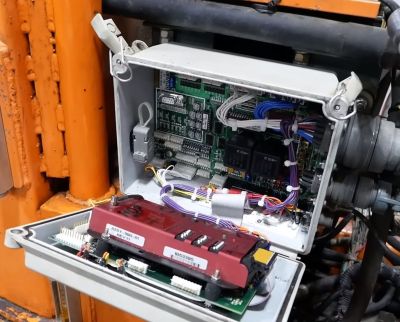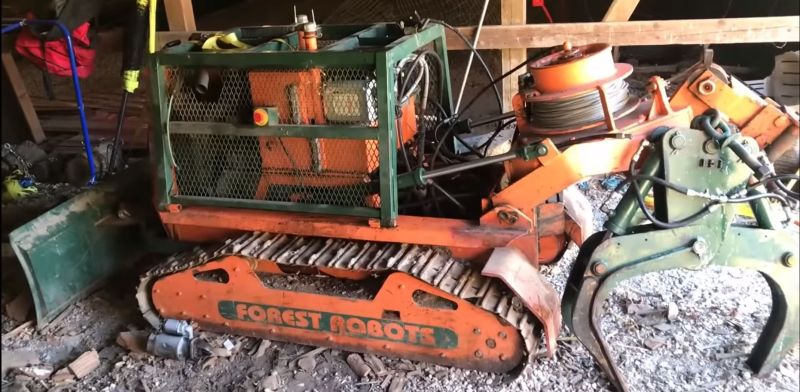There are many places where you’d want to use remotely controlled robots, but perhaps forestry isn’t the first application to come to mind. Yet there are arguments to be made for replacing something like a big logging machine with grapple for a much smaller robot. The reduced ground pressure can be beneficial in fragile ecosystems, and removing the operator is much safer if felling a tree goes wrong.
This is where a US company called Forest Robots tried to come in, with their Logg Dogg, of which [Wes] over at Watch Wes Work found a very unique prototype abandoned in a barn, courtesy of Zuckerberg’s marketplace of wonders.

After lugging the poor abandoned robot back into a warm repair shop, he set to work on figuring out what it was that he had bought. At the time he knew only that it was some kind of logging robot, but with no model number or name on the robot, it was tough to find information. Eventually he got tipped off about it being the Logg Dogg, with even a video of the robot in action, helpfully uploaded to YouTube by [Hankey Mountain Garage] and embedded below for your viewing pleasure.
As [Wes] noticed during teardown and inspection was that it has that distinct mix-and-match feel to it of a prototype, ranging from metric and US customary bolts to both European and US/Canadian supplied components. Although it has two RF receivers on the device, no remote(s) came with the device, and the seller only knew that it was already in the barn when they purchased the place. After getting the engine working again on the robot, [Wes] contacted one of the people behind the robot: [Dean Edwards], a professor at the University of Idaho, hoping to learn more about this robot and how it ended up abandoned in a barn.
Hopefully we’ll find out in a Part 2 whether [Wes] got a response, and whether this robot will get a second chance at life. Meanwhile, in countries such as Portugal such robots are already finding significant use, including for fire protection in its forests, tackling difficult terrain more easily than humans. With forest fires an increasing risk, perhaps the Logg Dogg and kin could find a use there.
Thanks to [Keith Olson] for the tip.















Logging is dangerous AF.
It’s an obvious choice for automation. But not easy.
Have to program it to finish off/dispose of tree sitting protestors…Without it being obvious.
Was a problem just waiting for AI. Now you can say, ‘prove it’. The hippies in the tree houses in the training set were put there accidentally. By unpaid intern before we put the training dataset under version control.
I don’t care whether or not you agree with any given protest, but arguing – perhaps jokingly, perhaps not – for murdering people is downright shitty.
Do better.
No.
Don’t feed the trolls.
The murders are the eco terrorists who spiked trees to try to kill loggers
You shouldn’t argue against the right to protest because you disagree with a particular message – you might need that right yourself some day
What “right to protest”? Is what you’re saying that anyone who declares that they are acting “for the greater good” should be allowed to break the law, cause property damage and arbitrarily disrupt other people’s peaceful activities, as long as said disruption does not involve violence against human beings (or animals)? Because that’s what people usually seem to have in mind when they speak of this alleged “right”. Civil disobedience, basically. And I strongly disagree with that.
The social contract should apply to everyone, not just those who aren’t self-righteous busybodies. If anyone’s strong personal conviction was allowed to overrule the protections we are supposed to have against interference by others, civilization would collapse. (“I believe this substation is giving me cancer, so I’ll blow it up. (Taking care not to injure anyone in the process, of course, because I’m non-violent like that.)”, etc.) If you want to make the world a better place, go ahead, but do it in your own backyard.
That said, I agree that wishing death upon your opponents usually doesn’t contribute anything to the discussion. And I guess I’m being off-topic and opinionated myself. I’d genuinely like to know how someone on the other side of this issue is thinking about the scope and ramifications of the “right to protest”, though.
Had the opportunity to troubleshoot electrical issue on a remote controlled trench roller years back. An excavator could set it in a narrow trench (to compact gravel bed for piping etc.) and the operator would stay above and run it. I enjoyed testing the repair repeatedly in the gravel parking lot. IIRC it was made by Wacker, 2 or 3 us tons, and IR xmit/rcv.
Now I want a logg dogg dang it
Oops wrong place! Sorry.
Replace the “brains” with an ESP32.
Dozer blade, grapple claw, winch, diesel engine, so much goodness in a small tracked package!
Something every hacker would like under their Christmas tree! 🎄
….. I’d be a bit worried about the tree.
[Chuckle!]
I can’t imagine that anyone would like to use something that slow today.
I bet a horse would do a quicker job extracting the logs with even less pressure on the environment.
But I wonder how the horse would go about felling the tree.
You’ve obviously never been bitten by a horse !!
My sister was bitten by a moose
you can’t put a horse in a shed (and I mean shed, not a stable) for a month, forget about it and then just start it and use it for work…also this could be faster, a lot faster. Needs a more powerful engine though.
I actually used a horse for a couple of days of tree extraction and, yes, there’s a lot of advantages / dis-advantage. One advantage is that they’re semi-autonomous and can navigate a pathway through trees without crashing into them.
A disadvantage is the slash they need to walk over is going to injure them. Tracked vehicles don’t get their legs cut up when their hooves step on bits of tree all over the ground
Doesn’t seem like a robot to me. It is just radio controlled.
I didn’t realize the robots in the fighting competitions weren’t being radio controlled. I guess they crave violence autonomously?
Yes, I think you’re correct.
Those too are NOT robots. A robot is an automatic device. This is a drone (or does someone object to a ground device being called a drone?) or UGV, and so are the fighting “bots”.
The concept is not abandoned. Some german company called “Pfanzelt” bulids remote controlled machines like the “forrest robot”: https://www.pfanzelt.com/en/mini-felling-tractor/
On a forested back road in Germany I saw stacks of logs staged for transport on the side of the road. But there was no evidence of where they got the logs from. the adjacent stands of trees looked undisturbed. Anyone who has seen a logged plot in the US can spot the contrast.
If you log wisely, and without demolishing the forest ecosystem or the habitat for endangered species, there will never be protesters. It can be done. Our own health and well-being depends upon a healthy natural environment. Don’t contribute to the end of life on this planet, please.
Really, the question is if we clear cut ten acres , or we selectively cut 100 acres because the impact is spread out it’s not quite as visible, but which is more efficient, which is less impact on the environment, assuming “being able to tell they were there” is not a metric, but more whom produced more useable lumber with less carbon footprint, we all know the trees will grow back either way, maybe better in the clear cut area… but just keep looking down on the United States (it’s even fashionable these days) by clear cutting you allow sunlight in, allowing new trees to grow, on the pick and choose you may not notice on large scale, but standing where a tree was cut you’ll know, and may not be enough sunlight penetrating to spark new growth as well..
There’s a lot more to this. Clear cutting releases a lot of nutriets that are lost from the local forest, making the soil poorer for every clear cut that is done. Third generation stands are often found to be starved of vital minerals. These nutrients and soil carbon create various problems downstream. Significant amounts are also ofgassed to the atmosphere. Most of the carbon stores in boreal forests are in the soil, not the standing forest, and the forest here in Norway can grow for 80 years before they make up for what was lost.
Clearcutting and the following planting creates large areas of monuculture plantations (not forests) that are off the same age. These stands are very vulnerable to insect, honeyfungus and fire which will quickly release any recouped carbon.
Clearcutting destroys habitat locally, breaks up the landscape (many birds and animals don’t like to move in to open areas). It also changes the microbial composition of the soil, making it more vulnerable to invasive species because the soil becomes more bacterial dominated when some species of mycorrhizzal fungi die out and others have to survive as saprophytes.
Maybe it would catch on today if they had Snoop D. as a representative.
This was a project headed by Professor Dean Edwards of the University of Idaho in an attempt to create an semi autonomous logging robot.
https://www.uidaho.edu/engr/departments/chbe/our-people/emeriti/dean-edwards
A link to the grant awarded for his project.
https://www.sbir.gov/sbirsearch/detail/168608
An interview in which he talks about this project.
https://heritageproject.caltech.edu/interviews-updates/dean-edwards
A lot of underground mining machinery is all remotely controlled now. Why not forestry, it’s dangerous work as well.
👍 I agree